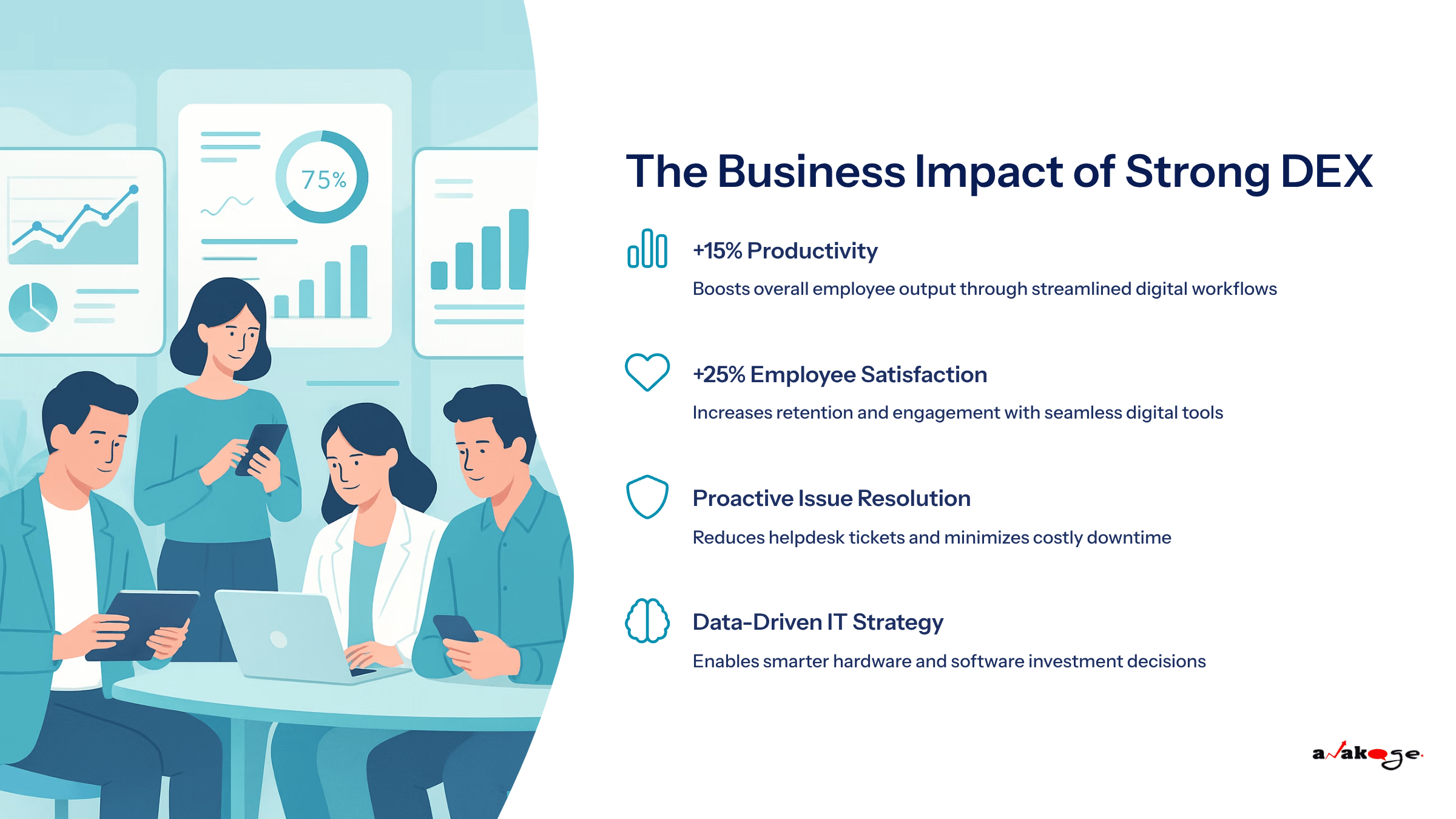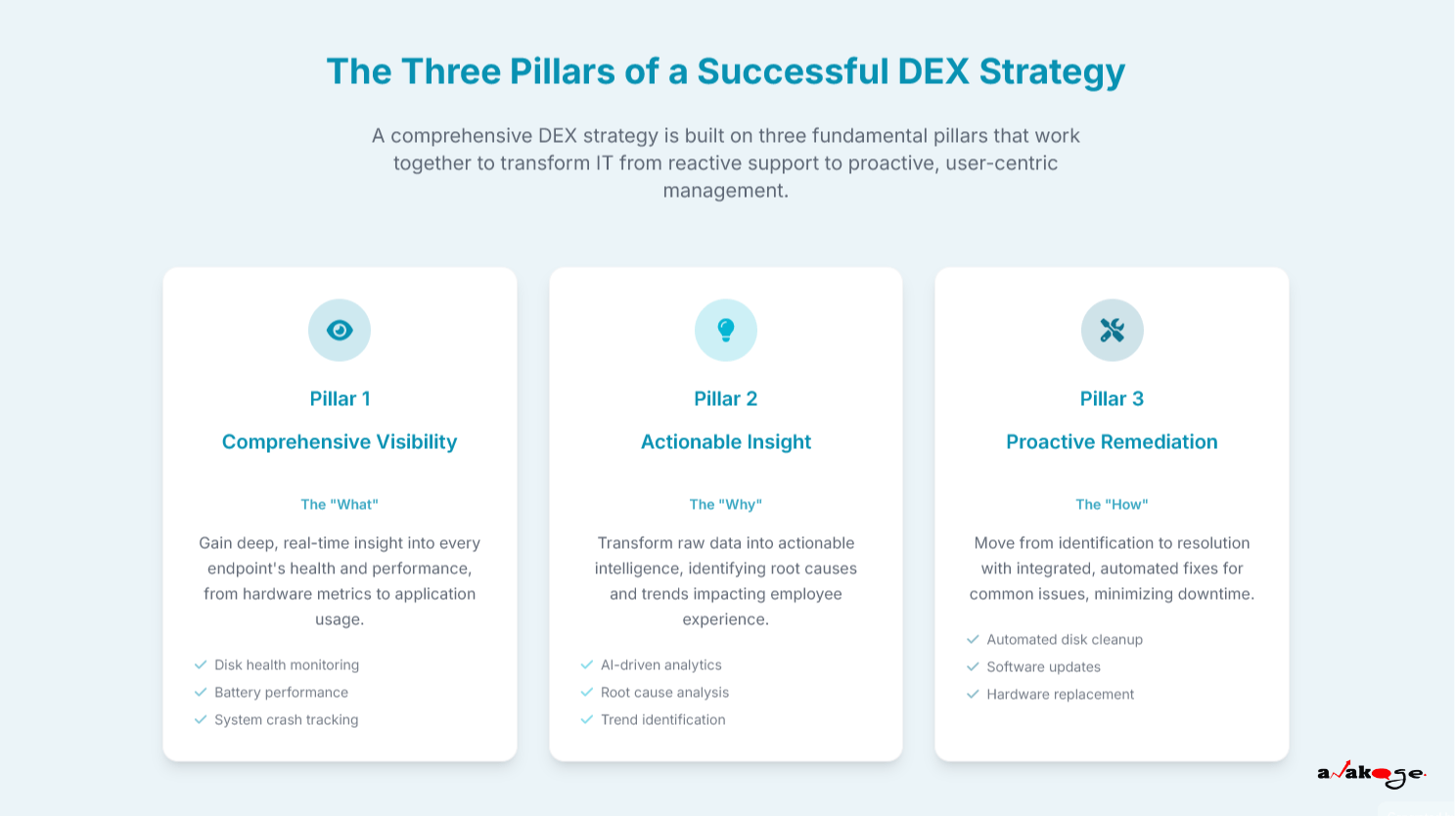Contents
- 1 The Modern Guide to Improving Digital Employee Experience (DEX)
The Modern Guide to Improving Digital Employee Experience (DEX)
In the modern digital workplace, the quality of an employee’s interaction with technology is no longer a matter of convenience, it’s a critical driver of productivity, engagement, and retention. Digital Employee Experience (DEX) has emerged as a key focus for IT leaders, shifting the paradigm from managing devices to managing the actual experience of the user. A poor DEX, characterized by slow boot times, frequent application crashes, and reactive IT support, leads to frustration and lost productivity.
This guide provides a practical overview of what DEX is, why it’s essential for business success, and how a proactive, data-driven approach can transform your employees’ relationship with technology.
What is Digital Employee Experience (DEX)?
Defining DEX in the Modern Workplace
Digital Employee Experience (DEX) encompasses the entirety of an employee’s interactions with the technological tools and systems they utilize in their professional environment. This includes:
- Hardware: Laptops, desktops, and mobile devices.
- Software: Operating systems and various business applications.
- Network Services: The connectivity that supports these technologies.
A robust DEX signifies that these technological touchpoints are not only functional but also reliable, consistently responsive, and intuitively designed. The ultimate aim is to empower employees, enabling them to perform their tasks efficiently and effectively, free from the hindrances of technological friction.
The Shift from Device Management to User-Centric Experience
Historically, IT departments focused on device-level management, with KPIs such as system uptime and device availability. While important, these metrics fail to capture the actual quality of the employee’s interaction.
Modern DEX management represents a significant paradigm shift, moving beyond purely technical aspects to prioritize user-centric metrics like:
- Application performance (e.g., load times, responsiveness).
- System boot times.
- Overall system stability (e.g., frequency of crashes or freezes).
This user-focused strategy acknowledges that technology is a tool to enable human productivity and satisfaction, and its effectiveness should be measured by how well it serves the end-user.
Why DEX is a Business Imperative, Not Just an IT Metric
The Tangible Business Impact of DEX
Investing in and prioritizing Digital Employee Experience (DEX) transcends the realm of mere employee satisfaction; it directly correlates with measurable and significant business outcomes. Organizations that strategically prioritize and enhance their DEX witness substantial improvements across various key performance indicators. For instance, research conducted by Forrester has compellingly demonstrated that companies boasting high DEX levels experience a significant 25% increase in employee satisfaction and a notable 15% boost in overall productivity . These figures underscore the profound impact that a well-crafted digital environment can have on an organization’s operational efficiency and employee morale.
The shift towards recognizing DEX as a critical business driver reflects a deeper understanding that technology is not just a support function but a fundamental enabler of employee performance and, consequently, organizational success. By fostering a digital workplace where technology is intuitive, reliable, and empowering, businesses can unlock significant gains in both employee well-being and overall productivity, ultimately contributing to a stronger bottom line and a more competitive market position. This strategic investment in DEX, therefore, becomes a crucial component of modern business strategy, directly influencing employee engagement, retention, and the overall capacity for innovation and growth.
Key Benefits: Productivity, Engagement, and Retention
A strong DEX strategy directly influences core aspects of organizational health:
- Increased Productivity: When technology functions seamlessly, employees dedicate more time to high-value tasks rather than troubleshooting technical problems.
- Improved Engagement & Retention: A frictionless digital experience reduces daily frustrations, fosters higher morale, and contributes to lower employee turnover rates.
- Proactive Issue Resolution: Modern DEX allows IT to identify and remediate technical problems before they impact employees, reducing helpdesk tickets and minimizing downtime.
- Data-Driven IT Strategy: By collecting and analyzing telemetry data, IT leaders can make more informed, evidence-based decisions regarding hardware procurement, software deployment, and infrastructure upgrades.
The Three Pillars of a Successful DEX Strategy
A comprehensive and effective Digital Employee Experience (DEX) strategy is built upon three fundamental pillars: comprehensive visibility, actionable insight, and proactive remediation. These pillars provide a structured approach to moving beyond reactive IT support and towards a proactive, user-centric model of technology management. By systematically addressing each of these areas, organizations can gain a holistic understanding of their employees’ digital interactions, identify the root causes of experience degradation, and implement targeted solutions to enhance productivity and satisfaction.
This framework ensures that DEX initiatives are not just ad-hoc improvements but part of a sustained, data-driven effort to optimize the digital workplace. The ultimate goal is to create an environment where technology seamlessly supports employee workflows, enabling them to perform at their best without unnecessary friction or interruption. Each pillar plays a critical role in this journey, from initial measurement and understanding to the final implementation of improvements.
Pillar 1: Comprehensive Visibility (The “What”)
You cannot improve what you cannot measure. This first pillar focuses on gaining deep, real-time insight into every endpoint’s health and performance. This goes beyond basic inventory and includes monitoring:
- Hardware Health: Disk performance, battery health, CPU, and memory usage.
- System Telemetry: System crashes, application response times, boot-up durations, and network quality.
This holistic view is crucial for identifying potential bottlenecks and understanding usage patterns.
Pillar 2: Actionable Insight (The “Why”)
The second pillar transforms raw data into meaningful understanding. An intelligent DEX platform uses advanced analytics to sift through the collected data to pinpoint the root causes of poor user experience. It answers the “why” behind performance issues; whether it’s due to local resources, network latency, or software conflicts.
Pillar 3: Proactive Remediation (The “How”)
The ultimate pillar is to proactively resolve issues, often before employees are even aware a problem exists. An effective DEX solution doesn’t just report a problem; it integrates workflows to fix it.
Want to learn more about how to proactively manage hardware?
Predictive Maintenance – Learn how to turn raw data into proactive support using BSOD logs and reboot statistics.
Hardware Management – Discover how to use DEX insights to proactively replace failing hard drives.
Integrated Remediation – Explore automated fixes for disk cleanup and system optimization.
The Anakage Advantage: Moving from DEX Visibility to Action with Agentic DEX
The Anakage Device Analytics (DEX) module is engineered to deliver a comprehensive, end-to-end solution for organizations seeking to meticulously manage and significantly improve their digital employee experience. While a multitude of tools in the market offer varying degrees of visibility into endpoint performance and user activity, Anakage distinguishes itself through an unwavering focus on integrated, actionable remediation. This means that the platform not only illuminates potential issues and areas for improvement but also provides the mechanisms to directly address them, often automatically. This capability is crucial for transforming DEX from a passive monitoring exercise into an active, results-oriented program.
By bridging the gap between insight and action, Anakage empowers IT teams to become proactive champions of a superior digital work environment, directly contributing to enhanced employee productivity, satisfaction, and overall business performance. The platform’s design philosophy centers on unifying deep, granular analytics with powerful automation capabilities, enabling a shift from traditional reactive support models to a more intelligent, efficient, and user-centric approach to IT management.
Key Differentiators
- Highly Granular Visibility: Deep insights into every aspect of endpoint health, from hardware metrics like battery and disk health to system-level data including OS patch levels, antivirus status, and BSOD events.
- User-Context-Aware Compliance: Tracks user-specific compliance issues like password aging or OneDrive usage, allowing for targeted, proactive reminders and support.
- Built-in Remediation Pathways: Integrated workflows to trigger automated fixes, from disk cleanup to software updates; moving seamlessly from visibility to action.
The Role of Agentic AI in Enhancing DEX
Agentic AI refers to systems that can perceive their environment, make decisions, and take actions autonomously. In DEX management, this means AI-driven agents (like Anakage’s proactive cobots) can continuously monitor the digital environment, identify anomalies, and initiate corrective actions without direct human intervention.
Lightweight and Flexible Deployment Options
Anakage offers flexible deployment to suit various IT environments:
- Lightweight Agent: For full control and comprehensive remediation capabilities with a minimal resource footprint.
- Agent-less Fallback: An alternative for environments where agent installation is challenging, providing read-only visibility across a wider range of devices.
Ready to experience the future of DEX?
[Schedule a Personalized Demo Today]
Have you read about our last release? Click here to read!
Frequently Asked Questions (FAQ)
Addressing Common Queries about DEX and Anakage’s Solutions
Q: What exactly is Digital Employee Experience (DEX)?
A: Digital Employee Experience (DEX) refers to the entirety of an employee’s interactions with the technology they use at work. This includes hardware (like laptops and mobile devices), software (operating systems and business applications), and network services. A good DEX means this technology is reliable, fast, and easy to use, helping employees work efficiently without frustration.
Q: Why is DEX suddenly so important?
A: DEX has become crucial because technology is now central to almost every job. A poor DEX leads to lost productivity, frustrated employees, and higher turnover. Research shows that investing in DEX directly improves employee satisfaction by up to 25% and productivity by 15% , making it a business imperative, not just an IT concern.
Q: How is DEX different from traditional IT management?
A: Traditional IT management often focuses on device uptime and basic functionality. DEX management is user-centric, focusing on the actual experience of the employee. It looks at metrics like application performance, system stability from the user’s perspective, and aims to proactively improve how employees interact with technology.
Q: What are the main benefits of a strong DEX strategy?
A: The key benefits include:
- Increased Productivity: Employees spend less time on IT issues and more on core tasks.
- Improved Engagement & Retention: A better digital experience reduces frustration and boosts morale.
- Proactive Issue Resolution: IT can identify and fix problems before they impact users.
- Data-Driven IT Decisions: Insights from DEX data help optimize technology investments.
Q: What are the “Three Pillars” of a successful DEX strategy?
A: The three pillars are:
- Comprehensive Visibility (The “What”): Gaining deep insights into endpoint health and performance.
- Actionable Insight (The “Why”): Understanding the root causes of poor digital experiences.
- Proactive Remediation (The “How”): Automating fixes and resolving issues before they impact employees.
Q: How does Anakage’s DEX solution help improve employee experience?
A: Anakage’s Device Analytics (DEX) module unifies deep analytics with powerful automation. It provides granular visibility into endpoint health, offers user-context-aware compliance monitoring, and most importantly, features built-in remediation pathways to automatically fix common issues . This moves IT from reactive support to proactive experience management.
Q: What is “Agentic DEX” and how does Anakage use it?
A: Agentic DEX leverages AI to enable systems to autonomously monitor, diagnose, and act to improve the digital employee experience. Anakage uses principles of Agentic AI to power features like proactive cobots that silently clean up junk files or predict hardware failures , making the digital workplace more resilient and self-healing.
Q: What deployment options does Anakage offer for its DEX solution?
A: Anakage offers flexible deployment to suit various IT environments. This includes a lightweight agent for full control and automated remediation, and an agent-less fallback option for read-only visibility on devices where an agent cannot be installed. This ensures broad compatibility and ease of integration.



